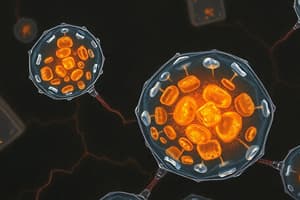Podcast
Questions and Answers
What is the primary result of apoptosis in the interdigital tissue of a developing mouse embryo?
What is the primary result of apoptosis in the interdigital tissue of a developing mouse embryo?
- Elimination of tissue between digits (correct)
- Regeneration of digits
- Promotion of muscle development
- Increased cell proliferation
Which pathway is activated by internal signals during apoptosis?
Which pathway is activated by internal signals during apoptosis?
- Extrinsic pathway
- Secondary pathway
- Receptor-mediated pathway
- Intrinsic pathway (correct)
What role does thyroid hormone play during the metamorphosis of a tadpole into a frog?
What role does thyroid hormone play during the metamorphosis of a tadpole into a frog?
- Stimulates tail regeneration
- Enhances growth of limbs
- Induces apoptosis in tail cells (correct)
- Increases feeding behavior
What initiates the extrinsic apoptosis pathway?
What initiates the extrinsic apoptosis pathway?
What is released by Bax and Bak to activate the apoptosome in the intrinsic pathway?
What is released by Bax and Bak to activate the apoptosome in the intrinsic pathway?
Which of the following statements about apoptosis is true?
Which of the following statements about apoptosis is true?
What is the consequence of mitochondrial DNA damage?
What is the consequence of mitochondrial DNA damage?
Which caspase is activated by the apoptosome during apoptosis?
Which caspase is activated by the apoptosome during apoptosis?
What is the main role of transcription factors in gene expression?
What is the main role of transcription factors in gene expression?
Which type of stem cells can give rise to any of the 220 cell types found in an embryo?
Which type of stem cells can give rise to any of the 220 cell types found in an embryo?
How do pluripotent stem cells differ from totipotent stem cells?
How do pluripotent stem cells differ from totipotent stem cells?
Which of the following statements about cell potency is true?
Which of the following statements about cell potency is true?
What occurs as a result of the action of transcription factors in a cell?
What occurs as a result of the action of transcription factors in a cell?
Which type of stem cells has the capacity to develop into a limited subset of cell types?
Which type of stem cells has the capacity to develop into a limited subset of cell types?
What is the primary characteristic of stem cells that distinguishes them from other cell types?
What is the primary characteristic of stem cells that distinguishes them from other cell types?
What function do transcription factors serve in relation to RNA polymerase?
What function do transcription factors serve in relation to RNA polymerase?
In what way do all body cells share a common feature despite their differentiation?
In what way do all body cells share a common feature despite their differentiation?
Which of the following best describes the process of cellular differentiation?
Which of the following best describes the process of cellular differentiation?
Which type of cell is primarily responsible for secreting mucus in the gastrointestinal tract?
Which type of cell is primarily responsible for secreting mucus in the gastrointestinal tract?
What role do transcription factors play in stem cell differentiation?
What role do transcription factors play in stem cell differentiation?
What distinguishes embryonic stem cells from adult stem cells?
What distinguishes embryonic stem cells from adult stem cells?
Cells that absorb nutrients in the gastrointestinal tract share a origin with which other type of specialized cell?
Cells that absorb nutrients in the gastrointestinal tract share a origin with which other type of specialized cell?
Which statement about stem cells is false?
Which statement about stem cells is false?
What is a major change that occurs in a cell during differentiation?
What is a major change that occurs in a cell during differentiation?
What is the primary function of endonuclease G during apoptosis?
What is the primary function of endonuclease G during apoptosis?
Which phase involves the recognition of apoptotic cells by macrophages?
Which phase involves the recognition of apoptotic cells by macrophages?
What happens during the degradation phase of apoptosis?
What happens during the degradation phase of apoptosis?
What leads to the depolarization and swelling of mitochondria in apoptosis?
What leads to the depolarization and swelling of mitochondria in apoptosis?
Which of the following accurately describes a morphological change occurring during apoptosis?
Which of the following accurately describes a morphological change occurring during apoptosis?
Which enzymes are primarily activated during the degradation phase of apoptosis?
Which enzymes are primarily activated during the degradation phase of apoptosis?
What is displayed on the outer cell membrane to signal phagocytosis during apoptosis?
What is displayed on the outer cell membrane to signal phagocytosis during apoptosis?
What are the typical outcomes of mitochondrial dysfunction during the apoptotic process?
What are the typical outcomes of mitochondrial dysfunction during the apoptotic process?
Which type of cells can be induced to reenter the cell cycle by growth factors?
Which type of cells can be induced to reenter the cell cycle by growth factors?
What is the primary distinction between pluripotent and totipotent stem cells?
What is the primary distinction between pluripotent and totipotent stem cells?
Which of the following cells has lost all capacity for proliferation?
Which of the following cells has lost all capacity for proliferation?
Which type of stem cell is limited to differentiating into a small number of cell types?
Which type of stem cell is limited to differentiating into a small number of cell types?
What is the function of transcription factors in cellular differentiation?
What is the function of transcription factors in cellular differentiation?
Modern biological theories of aging do NOT include which one of the following categories?
Modern biological theories of aging do NOT include which one of the following categories?
Which of the following statements is true regarding cellular aging based on programmed theories?
Which of the following statements is true regarding cellular aging based on programmed theories?
Which cells continuously divide and include surface epithelial cells of the skin?
Which cells continuously divide and include surface epithelial cells of the skin?
Flashcards are hidden until you start studying
Study Notes
Cellular Differentiation
- Cells differentiate to become specialized, leading to changes in size, shape, function, and metabolic activity.
- Tissues are organized communities of cells with specific functions.
- The endothelial tissue lining the gastrointestinal tract contains cells with various roles like nutrient absorption and mucus secretion.
Stem Cells
- Stem cells differentiate into various cell types.
- Stem cells can:
- Self-renew over a long time
- Are unspecialized
- Become specialized cells like muscle, blood, and brain cells
Stem Cell Potency
- Stem cell potency refers to their ability to differentiate.
- Totipotent stem cells (omnipotent) can form any cell type in an embryo and extra-embryonic cells.
- Pluripotent stem cells differentiate into any human cell type except extra-embryonic cells.
- .Multipotent stem cells have limited differentiation potential, typically within a specific lineage.
Transcription Factors in Differentiation
- Transcription factors regulate gene expression by binding to DNA and promoting or hindering gene transcription.
- They are responsible for the specialization of cells into various cell types.
Proliferative Capability of Cells
- Labile cells, like skin and gut epithelial cells, continuously divide.
- Stable cells, like liver, kidney, and pancreatic cells, divide when exposed to growth factors.
- Permanent cells, like nerve and cardiac muscle cells, do not typically divide.
Cellular Aging
- Aging theories include programmed and damage or error theories.
- Programmed theory suggests aging follows a biological timetable, potentially regulated by gene expression changes affecting maintenance, repair, and defense mechanisms.
- Damage or error theories posit that aging is caused by accumulating damage or errors in cells and tissues.
Apoptosis
- Apoptosis is a programmed cell death that can be induced by signals from other cells.
- It plays a crucial role in development, such as the removal of interdigital tissue during limb development.
- Apoptosis is also essential for regulating cell numbers and eliminating damaged cells.
Apoptosis Pathways
- Apoptosis is triggered by two primary pathways:
- The intrinsic (mitochondrial) pathway: triggered by internal signals like cell stress or DNA damage.
- The extrinsic (death receptor) pathway: activated by external signals from other cells.
Key Events in the Intrinsic Pathway
- Bax and Bak form pores in mitochondrial membranes, releasing cytochrome c.
- Released cytochrome c activates procaspase 9, forming the apoptosome.
- Activated caspase 9 triggers downstream caspases, leading to cell death.
Key Events in Apoptosis
- The cellular cortex (actin microfilaments) and the nucleus are disassembled by caspases.
- Endonuclease G fragments DNA.
- Apoptosis Inducing Factor (AIF) condenses chromatin and fragments DNA.
- The permeability transition pore complex in mitochondrial membranes leads to depolarization, uncoupling of oxidative phosphorylation, swelling, ATP depletion, and ultimately cell death.
Stages of Apoptosis
- Activation phase: signal reception and activation of caspases.
- Execution phase: mitochondrial release of pro-apoptotic factors executioner caspases activation, and dismantlement of the cell.
- Degradation phase: cell dismantling, DNA fragmentation, and formation of apoptotic bodies.
- Phagocytic phase: removal of apoptotic bodies by macrophages without inflammation.
Studying That Suits You
Use AI to generate personalized quizzes and flashcards to suit your learning preferences.




